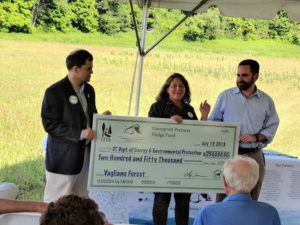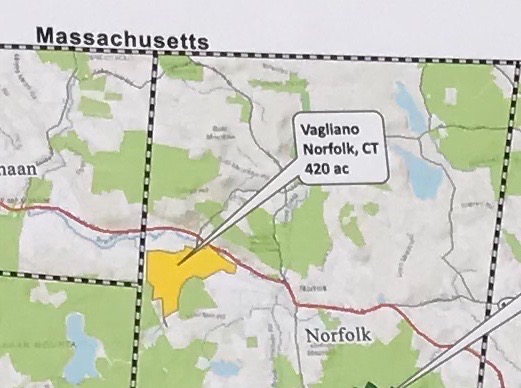CT DEEP to Purchase 420-Acre Vagliano Forest in Norfolk
Creates unsegmented corridor to Blackberry River
By William Gridley
The Connecticut Department of Energy and Environmental Protection (DEEP) is in the final stages of a transaction with the Vagliano family to acquire 420 acres of Norfolk forestland, tapping funds from the federal Highlands Conservation Act. The property, which includes the cold-water stream Roaring Brook, runs down the slope of Canaan Mountain to the Blackberry River. It is north of Mountain Road, south of Route 44, and to the west of Sunset Ridge toward the border with North Canaan. The land is being protected as conservation land with public access.
According to Tim Abbott, regional land conservation director and Greenprint director at the Housatonic Valley Association (HVA), “This purchase will preserve an essential link connecting Great Mountain Forest to the Blackberry River, just a short distance from Haystack Mountain State Park.”
The purchase of the Vagliano forest was one spark for a recent celebration in Kent of the Highlands Conservation Act (HCA), which provides federal funding for land conservation and protection. On July 13 in the Kent Land Trust field on Route 7, conservation groups erected a white tent and served cool drinks to local citizens and dignitaries including State Representative Brian Ohler (R-64), State Senator Craig Miner (R-20), first selectmen Curtis Rand of Salisbury and Bruce Adams of Kent and representatives of several Litchfield County land trusts.
The guest of honor, Senator Chris Murphy, gave a speech about why he believes that protecting open space, fields and forests is so important to the health and welfare of the state’s citizens. He has been a strong supporter of the Highlands program, which has provided more than $8 million since 2004 to support land conservation, protecting 1,630 acres so far, in what is known as the Highlands region, the massive multistate forestland that runs from Pennsylvania and New Jersey up into New York and Connecticut.

DEEP Commissioner Rob Klee received a $250,000 check fromLynn Werner, executive director of the HVA.
As part of the celebration, DEEP Commissioner Rob Klee received a large check from Lynn Werner, executive director of the HVA. Tim Abbott explained that this private $250,000 donation from HVA’s Greenprint Partners Pledge Fund was instrumental to the Vagliano deal. It provided one-eighth of the land acquisition cost. He underscored the importance of similar “joint private-public efforts that will soon enable another 1,000 acres to be conserved and protected.” Funds from the HCA provided around one-third of the acquisition cost, while other public sources provided the balance of just over 54 percent. Some of that additional funding comes from the federal Pittman-Robinson Act, which uses tax money from firearms and ammunition to help states acquire lands for wildlife management.
If you are a Norfolk or Canaan resident, this news is significant because the DEEP purchase will permanently protect an existing forest connection. Yet there are additional considerations which merit discussion.
Norfolk is already among the most forested and land-protected townships in Litchfield County. Some ask whether there should be practical limits to additional protection. Conserved or special-status forest lands confer considerable benefits, such as privacy and protection of wildlife habitat, nature and biodiversity. However, these benefits come at a cost, for example a reduction in local property taxes. The state now recommends that private property classified as Public Act 490 forest land be valued at $240 per acre. In Norfolk, after the upcoming 2018 revaluation, such a 420-acre parcel would be subject to around $1,550 per year in property taxes. When the state acquires forest land it pays zero local property tax. However, it does partially reimburse the locality for lost revenue: according to the Assessor Michelle Sloane, the reimbursement rate last year was 18 percent for state-owned properties.
On the other hand, state foresters worry about the prospect of a “silver tsunami” or the sale by aging landowners of interior woodland for development. In a 2015 joint DEEP Forestry Division and Yale School of Forestry and Environmental Studies study, titled “Understanding Connecticut Woodland Owners,” it was noted that 140 individual families own half of the 1.8 million acres of Connecticut woodland, and 85 percent of such owners are 50 years old or older and will face estate planning decisions in the coming decades.
Whether owners of woodlands decide to convert them to other uses is “a matter of significant public interest and environmental concern,” Klee was quoted as saying in the 2015 study. One way or another, the wisdom of state ownership of land, land use issues and the trade-offs between land conservation and property tax revenue will continue to be discussed and debated for years to come.
Map courtesy of Housatonic Valley Association. Photo by William Gridley.

